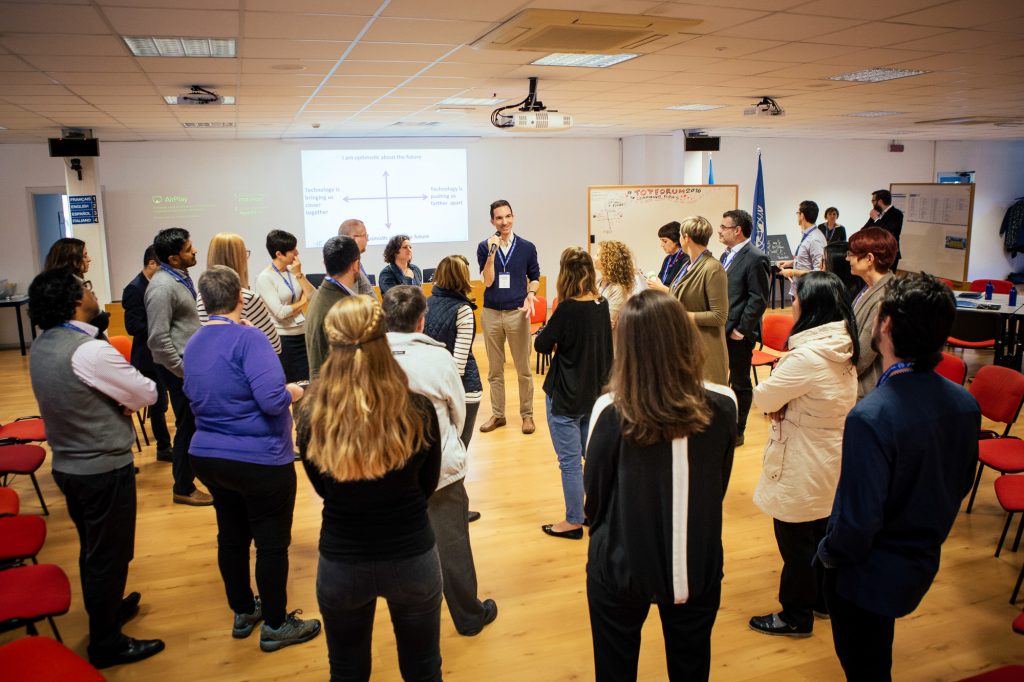Sociometrics

Understanding social structures and systems
Overview
Sociometrics require a high level of interaction among participants, and can be an effective approach to ice-breakers. In learning, sociometric activities engage people in representing social dynamics using means such as Web 2.0 technology or physical spaces. It allows groups of people to identify factors that they have in common, and to get an overview of networks and structures. Social network analysis and social mapping are two of its most common applications in professional learning environments.
How to use it
- Visualize social systems and understand complex structures.
- Connect large groups and develop and expand networks.
- Foster sharing and create an open environment.
- Introduce participants to one another.
- Help manage conflict.
How to apply it
Start:
- Identify objectives for an introductory exercise before using Sociometrics as an ice-breaker.
- Prepare a series of questions or statements related to the participants themselves or the subject matter. Create questions related to personal backgrounds if the objective is purely to introduce people.
- Formulate questions about the subject matter to activate past learning and gain insight into existing knowledge before the training itself.
Setting:
A room large enough to accommodate several groups.
Materials:
Flip-charts or signs to identify the spaces that relate to each question answer.
Time/Steps:
- Identify the physical spaces that represent each answer (use a sign, flipcharts or vocal identification).
- Ask the participants the question, and instruct them to gravitate to the space or group that is most relevant to them.
- Tell the participants to discuss the issue and identify one key reflection, such as a common reason for the selection, to share with the other groups.
- Repeat the process 1 to 3 times with different sets of questions or statements, to encourage the largest possible mixing of participants.
- Debrief in an informal group session to reiterate key observations and collect reflections from participants.
How to adapt it
- Enhance the level of interaction: instruct participants to line up according to characteristics as simple as thumb size or amount of water consumed each day, as practical as total years of experience or the level of alertness compared to tiredness, or as personal as ranking introverts to extroverts or total number of countries visited.
- Use Sociometrics to inform action plans for forging partnerships or joint initiatives by creating collaborative visual representations of professional networks. Provide a large enough working space and appropriate canvas, such as an enlarged world map, or large sheets of blank paper, writing tools and point indicators. For more complex networks, provide several colours to indicate different types of connections, and diverse shapes to represent different types of ‘nodes’. Ensure that there is enough time to complete the visualization and to debrief afterwards. Plan in advance how the results will be captured and used, and be sure to translate the outputs into a format that participants can use easily.
- See the link in Resources below for two more variations and sample questions.
Case study
Title:
Ice-breaker
Activity:
Strengthening Labour Inspection workshop
Contact:
B.Sorensen@itcilo.org (Social Dialogue)
Description:
At the start of the workshop the facilitator had three objectives in mind: she wanted the participants to get to know each other in a fun way, she wanted to mix the group right from the start and she wanted all the participants to be treated in the same way regardless the position they held in their organisation. To achieve these objectives the facilitator asked the group to divide themselves. In order to divide themselves the participants had to talk to each other. The participants were asked to divide themselves in three groups depending on how many years of experience they had in their institutions (less than 3, more than 3 but less than 5, more than 5). By applying the sociometrics methodology no pressure was put on the person with the highest ranking position by the rest of the group, which would have been the case when using a standard introduction round.
Tips
- The exercise must demonstrate to participants that they are active agents in the process.
- Gradually include considerations on the wider context, rather than instantly introducing all factors, to promote easy understanding of the exercise, and avoid overwhelming the participants.
- Avoid long exercises, as people tend to get tired or bored after about 20 minutes.
- Ensure that there are good acoustics in the room, so that instructions can be heard over any movement of participants.
- Creating diagrams, graphs and tables can be revealing about the nature of the networks. However, they are often hard to understand and interpret.
Resources
- Sample questions for “walk-to” or “find someone” variations: http://wilderdom.com/games/descriptions/GetToKnowYouSociometricQuestions.html





